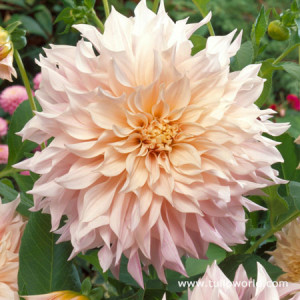 Planting anything is an investment in hope and optimism. You put a seed or young plant in the ground because you believe that with time and care, it will turn into something that resembles the gorgeous specimen on the plant tag or catalog page. It might also give you flowers, food, or shade. The whole plant growth process—from acorn to oak tree—can be explained scientifically, but even though I have been a gardener all my life, it always seems like a miracle to me.
Planting anything is an investment in hope and optimism. You put a seed or young plant in the ground because you believe that with time and care, it will turn into something that resembles the gorgeous specimen on the plant tag or catalog page. It might also give you flowers, food, or shade. The whole plant growth process—from acorn to oak tree—can be explained scientifically, but even though I have been a gardener all my life, it always seems like a miracle to me.
In times of crisis, I look for signs of hope. Right now, in spring, I see them all around me. The Korean spice viburnum or Viburnum carlesii that was partially demolished by a falling tree limb last year is back and covered with round, clove-scented flower clusters. The daffodils are glorious and the hyacinths divine. Many of my established hellebores have self seeded and the seedlings are now healthy little plants that I can move around the garden. The flowering quince is bright with an avalanche of flowers. All of that abundant growth means that I can follow the current movement and travel restrictions and still find spiritual solace in my front and back yards. I wish everyone could share my good fortune.
Now I have made a new investment in hope and optimism by ordering lots of colorful dahlias. I chose a mix called “Summertime Splendor”, which advertises itself as “varieties of different shapes and sizes…from coral through deep rosy pink to pastels.” The twelve dahlia tubers should arrive in a week or two and will go in my front border as soon as the ground warms up a bit more.
Dahlias are late summer/early fall plants, so I won’t see the fruits of these particular labors for some time. Just as I always plant fall tulips and daffodils in the knowledge that spring will eventually arrive, I’ll plant these dahlias in the hopes that by the time they bloom, all the suffering from coronavirus will be a thing of the past.
Dahlias have made a long journey from their native Mexico, arriving in Spain in about 1804, courtesy of European plant explorer Frederick van Humboldt. They were introduced shortly afterward into England by Lady Holland, wife of the British ambassador to Spain, where the first flowers bloomed in the conservatory of the family’s estate, Holland House. Laden with the name ‘Cocoxochitl” at first, they were later called “Georgina”, until the great plant taxonomist Linnaeus finally christened them “Dahlia”, after one of his Swedish pupils, Anders Dahl.
The original species dahlias were propagated and hybridized, becoming popular as garden and florist’s flowers. They have gone in and out of fashion many times, and are currently enjoying resurgence.
The universe of dahlias is large. Some plants are extremely tall, while others hug the ground. There are the many-petaled “dinner plate” types, with enormous blooms up to 10 inches wide. There are the small collarette varieties that look almost daisy-like, with flowers that span only about four inches. Waterlily dahlias resemble their namesake water plants, with rounded petals, while cactus dahlias feature narrow, spiky petals. Pom pons look like big round buttons. All come in an array of colors, and some, have dramatic near-black foliage, adding an extra dimension to these garden divas.
 Depending on your taste, you can indulge in delicate pastels or big, brassy reds, oranges and yellows. Dahlias range throughout the color spectrum, except for true blue, which is not in their genetic wheelhouse.
Depending on your taste, you can indulge in delicate pastels or big, brassy reds, oranges and yellows. Dahlias range throughout the color spectrum, except for true blue, which is not in their genetic wheelhouse.
As garden flowers go, dahlias are easy to grow. The tubers or young plants should be given as much sun as roses or tomatoes—about six hours per day. Once established, they don’t mind dry periods, but mulch is always helpful. Taller varieties have sturdy stems, but still need the help of plant stakes. Needless to say, many dahlias make excellent, long-lived cut flowers.
In fact, the only wrinkle in the fine fabric of dahlia existence is that the tubers are not hardy in cold winter climates. They can, however, be lifted in the fall and stored in a cool dry place for the winter, before being replanted in late spring.
If you want to get a great start with dahlias, go to Swan Island Dahlias, which has an amazing selection. They are at PO Box 700, Canby, OR 97013; (800) 410-6540; www.dahlias.com. Free print catalog. My mixed assortment is coming from White Flower Farm, P.O. Box 50, Route 63, Litchfield, Connecticut 06759; 1-800-503-9624; www.whiteflowerfarm.com. Free print catalog.
Many people know the proverb, “A society grows great when old men plant trees whose shade they know they shall never sit in.” I think a society grows more hopeful when its people can plant seeds or cultivate plants whose moments of glory are months away. I have invested a lot of hope in my dahlias, and, as the world turns, I believe they will deliver.
